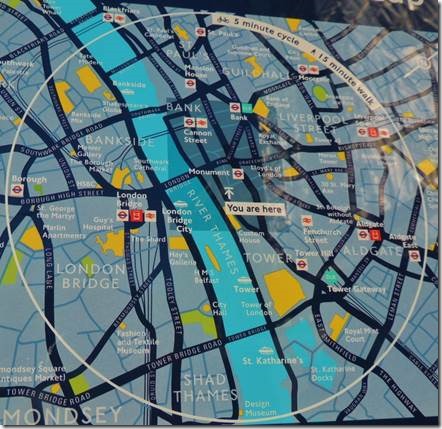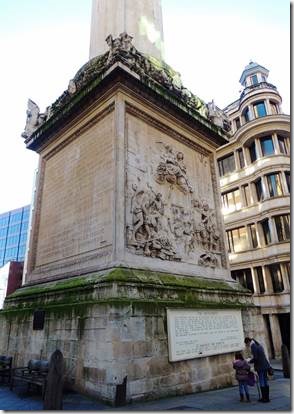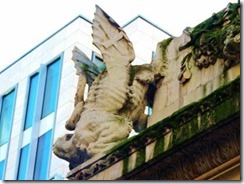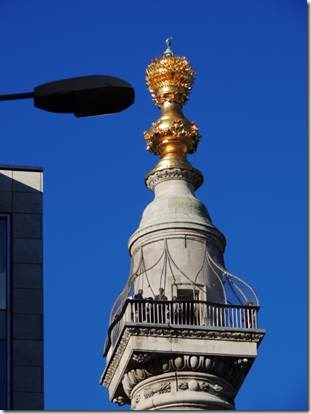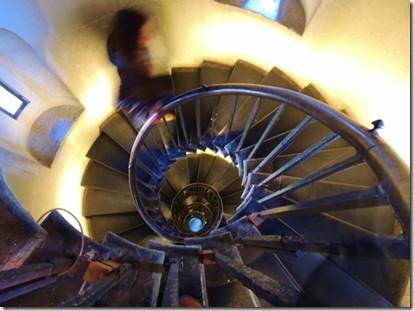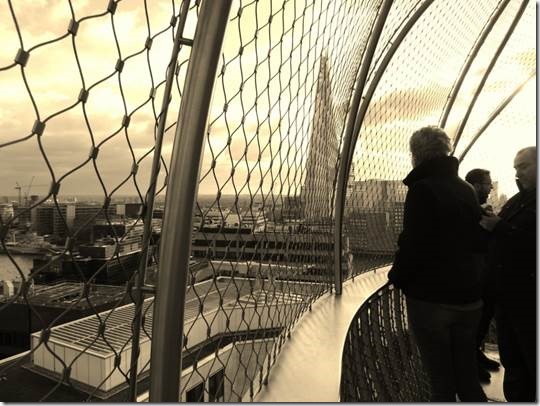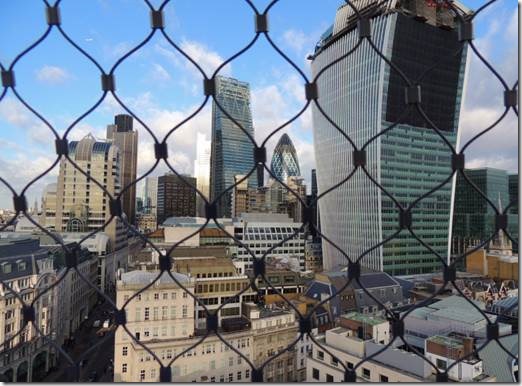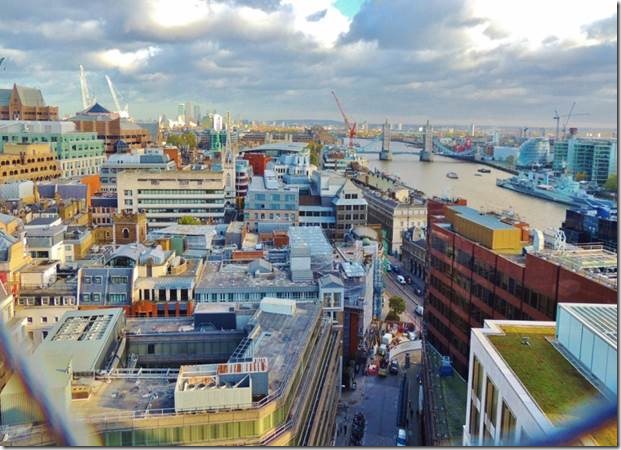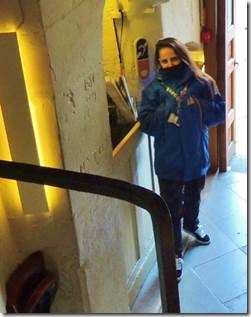Cheers,
Last Sunday Randal and I took part in our second www.walks.com tour. It focused on part of the famous London Square Mile that makes up the old city of London. We began the tour at the monument to the great fire of 1666, a date that once you learn is not hard to remember. The Great Plague was 1665-1666. Not a good time to be in London. Our tour started at the foot of The Monument to the great fire. While we were there, our guide Simon mentioned that the view from the top was worth the 311 steps. We didn’t have time Sunday so today, while Randal and I were out and about, we made The Monument our last stop. Randal waited in a coffee shop down on the street while I walked to the viewing platform. Before I started I’d asked the ticket seller how long it would take. “Five minutes” was her reply and that was just about right. I walked slowly and steadily giving the young man behind me an excuse to go slowly and steadily. I’d invited him to pass me but he said my speed was just fine for him too. So now that’s done, here’s the story of The Monument to the Great Fire. http://www.mydoramac.com/wordpress/?p=19008 has more information and photos from our visit to the Museum of London where there is an exhibit devoted to the Great Fire of 1666.
Ru
The Monument
“The Monument stands at the junction of Monument Street and Fish Street Hill in the City of London. It was built between 1671 and 1677 to commemorate the Great Fire of London and to celebrate the rebuilding of the City.
The fire began in a baker’s house in Pudding Lane on Sunday 2nd September 1666 and finally extinguished on Wednesday 5th September, after destroying the greater part of the City. Although there was little loss of life, the fire brought all activity to a halt, having consumed or severely damaged thousands of houses, hundreds of streets, the City’s gates, public buildings, churches and St. Paul’s Cathedral. The only buildings to survive in part were those built of stone, like St. Paul’s and the Guildhall.
As part of the rebuilding, it was decided to erect a permanent memorial of the Great Fire near the place where it began. Sir Christopher Wren, Surveyor General to King Charles II and the architect of St. Paul’s Cathedral, and his friend and colleague, Dr Robert Hooke, provided a design for a colossal
Doric column in the antique tradition. They drew up plans for a column containing a cantilevered stone staircase of 311 steps leading to a viewing platform. This was surmounted by a drum and a copper urn from which flames emerged, symbolizing the Great Fire. The Monument, as it came to be called, is 61 metres high (202 feet) – the exact distance between it and the site in Pudding Lane where the fire began.
The column was completed in 1677, and in accordance with Wren’s original intention, was at first used as a place for certain experiments of the Royal Society, but vibrations caused by ceaseless traffic proved too great for the success of these experiments and they were discontinued; thereafter the Monument became a place of historic interest, unique of its kind, providing visitors with an opportunity to look across London in all directions from a height of about 160 feet, being the level of the public gallery.
Sir Christopher Wren’s flame-topped Monument to the Great Fire of 1666 is the tallest isolated stone column in the world.
http://www.themonument.info/history/introduction.html
Our guide Simon explained that when rebuilding the King insisted that the City be rebuilt as it had been even recreating the small alleyways and lanes rather than lay the city out as a grid or spoke or something more logical. That’s why London is just as it had been in 1666.
|
Only at a distance could I get a “top to bottom” photo of The Monument |
|
“The column stands on a plinth, three faces of which carry Latin texts with translations. “ North face – Translation of the Latin inscription: In the year of Christ 1666, on the 2nd September, at a distance eastward from this place of 202 feet, which is the height of this column, a fire broke out in the dead of night, which, the wind blowing, devoured even distant buildings, and rushed devastating through every quarter with astonishing swiftness and noise. It consumed 89 churches, gates, the Guildhall, public edifices, hospitals, schools, libraries, a great number of blocks of buildings, 13,200 houses, 400 streets. Of the 26 wards, it utterly destroyed 15, and left 8 mutilated and half-burnt. The ashes of the City, covering as many as 436 acres, extended on one side from the Tower along the bank of the Thames to the church of the Templars, on the other side from the north-east gate along the walls to the head of Fleet-ditch. Merciless to the wealth and estates of the citizens, it was harmless to their lives, so as throughout to remind us of the final destruction of the world by fire. The havoc was swift. A little space of time saw the same city most prosperous and no longer in being. On the third day, when it had now altogether vanquished all human counsel and resource, at the bidding, as we may well believe, of heaven, the fatal fire stayed its course and everywhere died out. *[But Popish frenzy, which wrought such horrors, is not yet quenched.] * These last words were added in 1681 and finally deleted in 1830. http://www.londonremembers.com/memorials/the-monument-west-and-north |
|
The bas relief on the front of The Monument “The bas relief by Cibber is worthy of close examination. It shows a woman on the left (representing the City) languishing on some ruins. Winged Time supports her and a female figure points with a winged sceptre at the clouds which contain two more bare-breasted lovelies, one with a cornucopia (Plenty) and one with a laurel branch (Praise). Behind the group on the left are some figures waving their hands in distress and behind them, the cause, buildings with smoke and flames pouring forth. To the right of this group can be seen a beehive, symbol of industry. And is that the City dragon/griffon we see at the bottom left creeping out from under the ruins? The main figure in the group to the right is King Charles II standing at the top of some steps. He directs three more scantily-clad women down the steps towards poor City. They represent: Science brandishing a figure of many-breasted Nature and with a very strange headdress; Architecture clutching some plans and a pair of compasses, and Liberty waving her cowboy hat in the air. To the right of the Kings stands his brother, the Duke of York (the future King James II) clutching a garland, presumably destined for the City. Behind James are two more female allegorical figures: to the left Justice wearing a coronet and to the right Fortitude brandishing a sword in one hand while the other controls the leashed lion at her feet. Behind this group the reconstruction of the City progresses, with workmen scrambling over scaffolding. Below the steps on which this group stands, squeezed into an arched cavern is an ugly female figure, Envy eating her own heart.” http://www.londonremembers.com/memorials/the-monument-west-and-north When I enlarge the photo Envy looks like a well-muscled man to me. |
|
Dragons and crosses are the symbols of Saint George the patron saint of The City of London. http://www.seiryu.org.uk/ppp/city-dragon.html “ Caius Gabriel Cibber executed the sculpture on the west panel, and the four dragons at the base were the work of Edward Pierce, Jnr., a sculptor and architect frequently employed by Wren. “ |
|
“…on the abacus is a balcony encompassing a moulded cylinder, which supports a flaming urn or vase of gilt bronze, symbolizing the Fire. Defoe quaintly describes the Monument as “built in the form of a candle”. the top making a “handsome gilt flame like that of a candle”. http://www.themonument.info/history/construction.html The wire cage isn’t visible so I wondered if I would have the nerve to actually walk out onto the balcony. |
|
“Within is a spiral staircase with a total of 345 steps; after climbing 311 the staircase opens to a public balcony providing a fine view of the metropolis..” http://www.themonument.info/history/construction.html “Each step is exactly 6 inches high. The very top of the edifice has a hinged lid and the spiral staircase surrounds a void (rather than a solid shaft) so the whole height can be used by a giant pendulum, or as a telescope, or (and who doesn’t want to do this?) for dropping things. “ http://www.londonremembers.com/memorials/the-monument-west-and-north Actually walking up was so bad. Randal and I had been out doing chores so I had already stretched my legs by the time I had to climb the stairs. They are small steps making climbing up less strenuous, but coming down, I really had to watch my step as the rise wasn’t as I’m used to in standard American architecture. |
|
The Shard off in the distance |
|
The Gherkin and the “Walkie-Talkie” building whose curved façade, during hot summer days, melted cars on the street below. “A London skyscraper dubbed the Walkie-Talkie has been blamed for reflecting light which melted parts of a car parked on a nearby street. What happened? It’s like starting a fire with a parabolic mirror. "Fundamentally it’s reflection. If a building creates enough of a curve with a series of flat windows, which act like mirrors, the reflections all converge at one point, focusing and concentrating the light," says Chris Shepherd, from the Institute of Physics. The half-finished 37-storey "Walkie Talkie"- nicknamed such because of its tapering rectangular design – is indeed a curvy building. Its design, which has also been compared to a brimming pint glass, has provoked controversy before. It transpires the car, a Jaguar on Eastcheap in the City of London, was parked at just the spot where the focused light landed. http://www.bbc.co.uk/news/magazine-23944679 Our guide said the design was supposed to have been a “money saving design modified from a more expensive plan” but now it’s costing them a fortune to fix the mess They should have followed the old British maxim, Penny wise, pound foolish.” |
|
The Thames and the Tower Bridge |
|
The ticket-taker was chilled but walking up and then down 311 stairs warmed me up. |
|
Randal held my new Daunt Book Shop bag while I climbed the Monument. |
|
Here I am back on DoraMac with my “I climbed The Monument” certificate which you receive as you leave. |
|
This is a great book shop! The Sunday Telegraph magazine had run a story about Elizabeth Jane Howard, who at 90, had just written the 5th book in her Cazalet Chronicles. The local libraries didn’t seem to have a copy on the shelves when I checked online so while we were out and about today, I bought Book One: The Light Years. And I also bought Ann Patchett’s small pamphlet The Bookshop Strikes Back about her own bookshop in Nashville and why she started it. My purchases were handed to me in this lovely Daunt Books cloth bag. The shop had a great collection and the guys who worked there were helpful and really well read. Super! |

